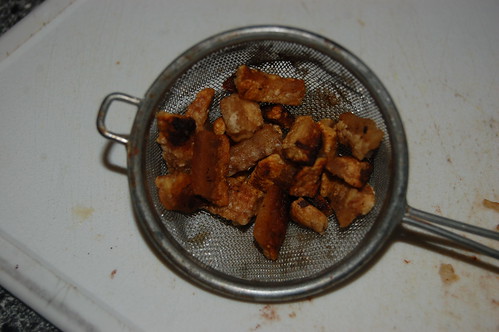To work out how to extract the fat from the meat, I had to go back to a wartime Ministry of Food advice leaflet which explained how best to use the meagre fat ration. I had some bacon rind and some fat cut from the joint we roasted at Christmas. The rind itself was more skin than anything else. We cut it off before grilling the bacon as it is quite thick.

Using the advice from the wartime leaflet, I chopped the bacon and fried it (no fat was added) until all that was let was the liquid fat and crispy bits of rind/skin (see photo above). The fat was poured through a sieve into a bowl in which it could solidify. The crispy rind can be added to soups (or used as a nibble).

The fat from the joint was chopped up and then added to a pan. Enough water to cover the bottom of the pan was added. Bring the pan to the boil and then let it simmer. Stir regularly. You need to let all the water evaporate. The fat lumps soon start to release the liquid fat (see photo above) and reduced down to a fraction of their size. Once they are little more than dry fibrous lumps (see below) strain the fat through a sieve and leave to cool and solidify in a bowl. The lumps can, like the rind, be added to soups.

The final product should look something like this:

2 comments:
I save the fat whenever we cook bacon (just pour it into a jar and pop it in the fridge) and do almost all my sauteing in it. Adds a delicious, subtle bacon flavor (which is never a bad thing, right?). Just discovered your blog (I read "Life on a Small Island", which you were featured with as one of 15 brilliant blogs. Love what I've read here so far and can't wait to dig through the troves. Thanks.
the common way to melt fat. we do it also with goose and duck. reading your blog, it seems to me that in our area more old knowledge is in everyday usage.
Post a Comment